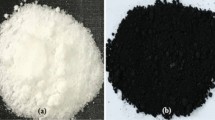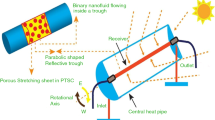Abstract
There is an overwhelming demand in many solar applications to evaluate and improve the thermal properties (dynamic viscosity and thermal conductivity) of working fluids to ensure that those fluids are the most efficient. This can be achieved via scattering of tiny solid (mono or hybrid) nanomaterials into conventional fluids. In this experimental study, the thermal properties of a distilled water-based MWCNT+Y2O3 combination with a 20:80 weight ratio were experimentally investigated. The proposed hybrid nanofluid, prepared by a two-step method, with Gum Arabic as a surfactant, had half total volume concentrations of (0.01–0.2% vol) in the temperature range of 20–60°C, where stability has been reached and checked with various technics. The results demonstrate that the thermal conductivity coefficient increases with both temperature and concentration, especially at high concentrations and high temperatures. The maximum enhancement observed reaches 13% at a volume concentration of 0.2% and temperature of 60°C. As for the viscosity, the relative viscosity was obtained for various temperatures and concentrations, the maximum results reaching 8.85 at a concentration equal to 0.2%. Finally, correlations for the hybrid nanofluid thermal conductivity ratio and relative viscosity were suggested under the mentioned limitations, and the calculated experimental results demonstrate good accuracy with the proposed correlations with R2 = 0.99 for the thermal conductivity ratio and R2 = 0.95 for the relative viscosity.














Similar content being viewed by others
REFERENCES
Kamel, M.S., Al-Oran, O., and Lezsovits, F., Thermal Conductivity of Al2O3 and CeO2 Nanoparticles and Their Hybrid Based Water Nanofluids: An Experimental Study, Period. Polytech. Chem. Eng., 2021, vol. 65, no. 1, pp. 50–60.
Al-Oran, O. and Lezsovits, F., A Hybrid Nanofluid of Alumina and Tungsten Oxide for Performance Enhancement of a Parabolic Trough Collector under the Weather Conditions of Budapest, Appl. Sci., 2021, vol. 11, no. 11, p. 4946.
Raman, N.S., Prabhu, K.S., and Kandasamy, R., Heat Transfer Effects on Hiemenz Flow of Nanofluid over a Porous Wedge Sheet in the Presence of Suction/Injection Due to Solar Energy: Lie Group Transformation, J. Eng. Phys. Thermophys., 2014, vol. 23, no. 1, pp. 66–78.
Al-Oran, O. and Lezsovits, F., Enhance Thermal Efficiency of Parabolic Trough Collector Using Tungsten Oxide/Syltherm 800 Nanofluid, Pollack Period., 2020, vol. 15, no. 2, pp. 187–198.
Jakhar, S., Paliwal, M.K., and Purohit, N., Assessment of Alumina/Water Nanofluid in a Glazed Tube and Sheet Photovoltaic/Thermal System with Geothermal Cooling, J. Therm. An. Calorim., 2021, pp. 1–18.
Meena, P., et al., Enhancement of the Performance Heat Transfer of a Thermosyphon with Fin and without Fin Heat Exchangers Using Cu-Nanofluid as Working Fluids, J. Eng. Phys. Thermophys., 2014, vol. 23, no. 4, pp. 331–340.
Kaood, A., et al., Performance Analysis and Particle Swarm Optimization of Molten Salt-Based Nanofluids in Parabolic Trough Concentrators, Renew. Energy, 2021, vol. 177, pp. 1045–1062.
Minea, A. and Moldoveanu, M., Studies on Al2O3, CuO, and TiO2 Water-Based Nanofluids: A Comparative Approach in Laminar and Turbulent Flow, J. Eng. Phys. Thermophys., 2017, vol. 26, no. 2, pp. 291–301.
Al-Oran, O. and Lezsovits, F., Thermal Performance of Inserting Hybrid Nanofluid in Parabolic Trough Collector, Pollack Period., 2021.
Allahyari, S., et al., Investigating the Effects of Nanoparticles Mean Diameter on Laminar Mixed Convection of a Nanofluid Through an Inclined Tube with Circumferentially Nonuniform Heat Flux, J. Eng. Phys. Thermophys., 2016, vol. 25, no. 4, pp. 563–575.
Asadi, A., et al., The Effect of Surfactant and Sonication Time on the Stability and Thermal Conductivity of Water-Based Nanofluid Containing Mg(OH) 2 Nanoparticles: An Experimental Investigation, Int. J. Heat Mass Transfer, 2017, vol. 108, pp. 191–198.
Babar, H. and Ali, H.M., Towards Hybrid Nanofluids: Preparation, Thermophysical Properties, Applications, and Challenges, J. Mol. Liq., 2019, vol. 281, pp. 598–633.
Noorzadeh, S., et al., Thermal Conductivity, Viscosity and Heat Transfer Process in Nanofluids: A Critical Review, J. Compos. Compd., 2020, vol. 2, no. 5, pp. 175–192.
Al-Oran, O. and Lezsovits, F., Recent Experimental Enhancement Techniques Applied in the Receiver Part of the Parabolic Trough Collector–A Review, Int. Rev. Appl. Sci. Eng., 2020, vol. 11, no. 3; DOI:10.1556/1848.2020.00055.
Said, Z., et al., Optimizing Density, Dynamic Viscosity, Thermal Conductivity and Specific Heat of a Hybrid Nanofluid Obtained Experimentally via ANFIS-Based Model and Modern Optimization, J. Mol. Liq., 2021, vol. 321, p. 114287.
Sadri, R., et al., An Experimental Study on Thermal Conductivity and Viscosity of Nanofluids Containing Carbon Nanotubes, Nanoscale Res. Lett., 2014, vol. 9, no. 1, pp. 1–16.
Phuoc, T.X., Massoudi, M., and Chen, R.-H., Viscosity and Thermal Conductivity of Nanofluids Containing Multi-Walled Carbon Nanotubes Stabilized by Chitosan, Int. J. Therm. Sci., 2011, vol. 50, no. 1, pp. 12–18.
Chopkar, M., Das, P., and Manna, I., Thermal Characterization of a Nanofluid Comprising Nanocrystalline ZrO2 Dispersed in Water and Ethylene Glycol, Philos Mag., 2007, vol. 87, no. 29, pp. 4433–4444.
Devarajan, M., et al., Thermophysical Properties of CNT and CNT/Al2O3 Hybrid Nanofluid, Micro Nano Lett., 2018, vol. 13, no. 5, pp. 617–621.
Gupta, N., Gupta, S.M., and Sharma, S., Preparation of Stable Metal/COOH-MWCNT Hybrid Nanofluid, Mater. Today: Proc., 2020, vol. 36, pp. 649–656.
Kumar, D.D. and Arasu, A.V., A Comprehensive Review of Preparation, Characterization, Properties and Stability of Hybrid Nanofluids, Renew. Sustain. Energy Rev., 2018, vol. 81, pp. 1669–1689.
Nine, M.J., et al., Investigation of Al2O3-MWCNTs Hybrid Dispersion in Water and Their Thermal Characterization, J. Nanosci. Nanotechnol., 2012, vol. 12, no. 6, pp. 4553–4559.
Asadi, A., et al., Heat Transfer Efficiency of Al2O3-MWCNT/Thermal Oil Hybrid Nanofluid as a Cooling Fluid in Thermal and Energy Management Applications: An Experimental and Theoretical Investigation, Int. J. Heat Mass Transfer, 2018, vol. 117, pp. 474–486.
Zareie, A. and Akbari, M., Hybrid Nanoparticles Effects on Rheological Behavior of Water-EG Coolant Under Different Temperatures: An Experimental Study, J. Mol. Liq., 2017, vol. 230, pp. 408–414.
Esfe, M.H. and Esfandeh, S., Investigation of Rheological Behavior of Hybrid Oil Based Nanolubricant-Coolant Applied in Car Engines and Cooling Equipments, Appl. Therm. Eng., 2018, vol. 131, pp. 1026–1033.
Esfe, M.H., et al., A Novel Applicable Experimental Study on the Thermal Behavior of SWCNTs (60%)-MgO (40%)/EG Hybrid Nanofluid by Focusing on the Thermal Conductivity, Powder Technol., 2019, vol. 342, pp. 998–1007.
Tiwari, A.K., et al., 4S Consideration (Synthesis, Sonication, Surfactant, Stability) for the Thermal Conductivity of CeO2 with MWCNT and Water Based Hybrid Nanofluid: An Experimental Assessment, Coll. Surf., Physic. Eng. Asp., 2021, vol. 610, p. 125918.
Al-Oran, O., Lezsovits, F., and Aljawabrah, A., Exergy and Energy Amelioration for Parabolic Trough Collector Using Mono and Hybrid Nanofluids, J. Therm. An. Calorim., 2020, vol. 140, no. 3, pp. 1579–1596.
Bellos, E. and Tzivanidis, C., Thermal Analysis of Parabolic Trough Collector Operating with Mono and Hybrid Nanofluids, Sust. Energy Technol. Assess., 2018, vol. 26, pp. 105–115.
Inc., U.R.N. Nanomaterials Catalog, 2021; available from: https://www.us-nano.com/home
Sharma, S. and Gupta, S.M., Preparation and Evaluation of Stable Nanofluids for Heat Transfer Application: A Review, Exp. Therm. Fluid Sci., 2016, vol. 79, pp. 202–212.
Javadian, S., et al., Dispersion Stability of Multi-Walled Carbon Nanotubes in Catanionic Surfactant Mixtures, Coll. Surf. Physic. Eng. Asp., 2017, vol. 531, pp. 141–149.
Lemmon, E.W, McLinden, M.O., and Friend, D.G., Thermophysical Properties of Fluid Systems, NIST Chemistry WebBook, NIST Standard Reference Database Number 69, 2005.
Lanjewar, A., et al., Intensified Thermal Conductivity and Convective Heat Transfer of Ultrasonically Prepared CuO–Polyaniline Nanocomposite Based Nanofluids in Helical Coil Heat Exchanger, Period. Polytech. Chem. Eng., 2020, vol. 64, no. 2, pp. 271–282.
Moldoveanu, G.M., et al., Al2O3/TiO2 Hybrid Nanofluids Thermal Conductivity, J. Therm. An. Calorim., 2019, vol. 137, no. 2, pp. 583–592.
Author information
Authors and Affiliations
Corresponding author
Rights and permissions
About this article
Cite this article
Al-Oran, O., Lezsovits, F. Experimental Study of Thermal Conductivity and Viscosity of Water-Based MWCNT-Y2O3 Hybrid Nanofluid with Surfactant. J. Engin. Thermophys. 31, 98–110 (2022). https://doi.org/10.1134/S1810232822010088
Received:
Revised:
Accepted:
Published:
Issue Date:
DOI: https://doi.org/10.1134/S1810232822010088




